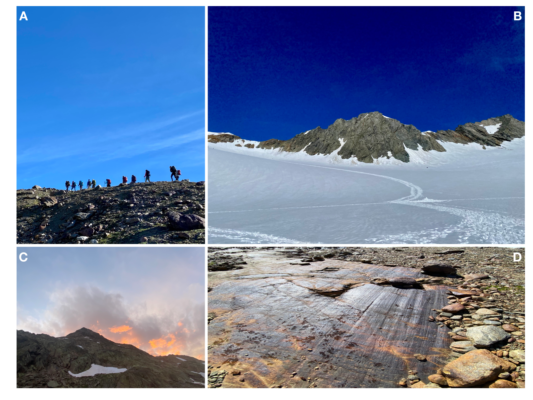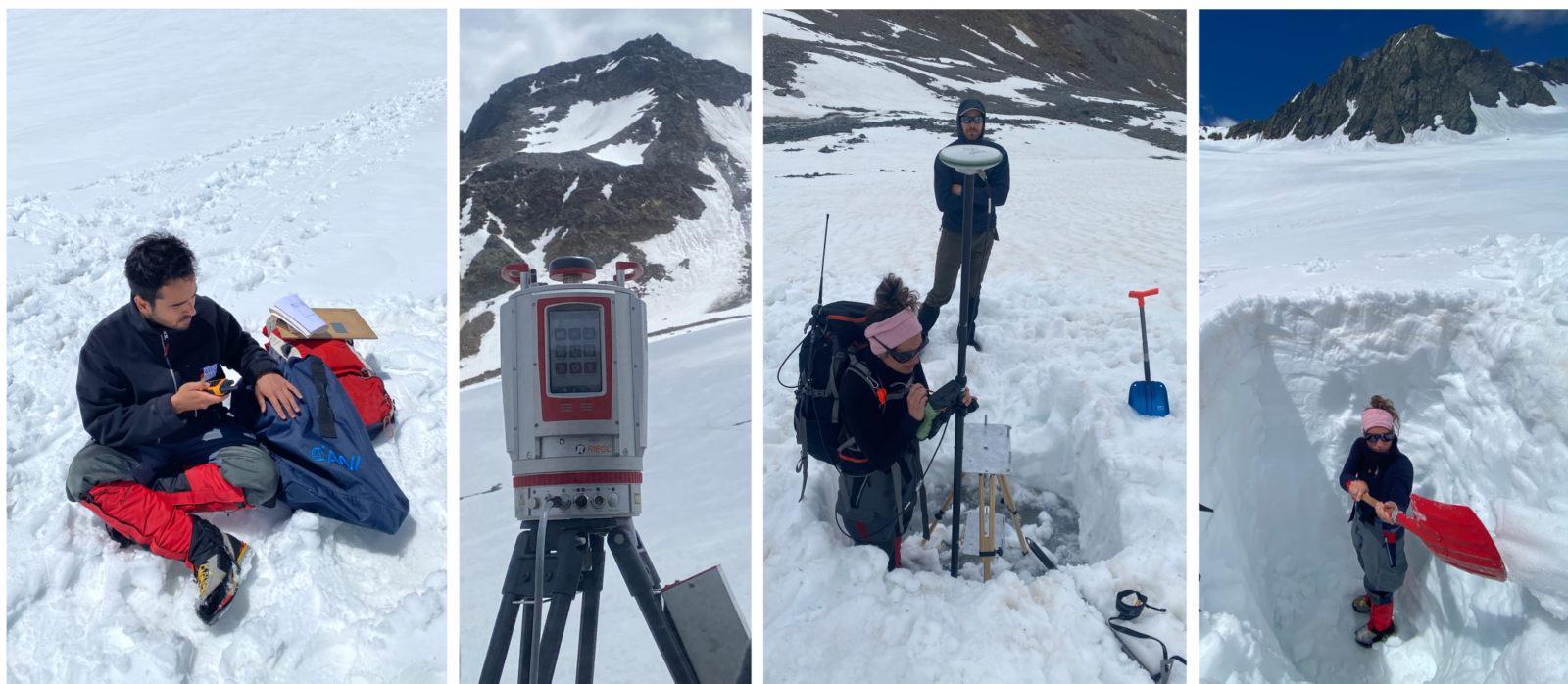
In July 2021, together with a group of MSc students from the University of Bremen, I set off from the flat plains of Northwest Germany and embarked on a journey to the mountainous regions of Austria, with the Vernagtferner Glacier as our final destination. My aim was to learn as much as I could in the glaciology field course offered by the university.
During my student days in Brazil, glaciers filled my imagination. However, until now I had only seen these striking features in text books and documentaries, unlike my European counterparts, who during their school days, had spent many winter vacations skiing in the Alps. Hiking thousands of meters above sea level, carrying heavy scientific equipment uphill could well be described as an exhausting activity. Yet, nervously pacing in anticipation to meet my first glacier, it was very easy to lose all sense of time. I was filled with curiosity and fascination for the breathtaking landscape. As I walked over rocky ground, streams of glacial meltwater and snow patches, the pastoral calm was only disturbed by the energetic sound of a river in the background. To me, as an appreciator of natural scenery, those crisp mornings breathing the cold and refreshing air of the mountains – still covered with the remains of winter snow – invoked the sensation of being in a world apart. After our first ascent to the top of the Ötztal Alps, I was tired but proud of my efforts to see the Vernagtferner Glacier (46.88N, 10.82E) for the first time. I stood triumphantly at the summit, in awe, surveying the glacial expanse before me, its snowy glare blindingly intense. A magnificent, timeless image of age-old geological processes at play, drawing me to understand its landscape-forming power. Scientists and artists describe the beauty of alpine glaciers in various ways. Arguably, poets are better equipped to report on the majesty of nature:
Ye Ice-falls! ye that from the mountain’s brow
Adown enormous ravines slope amain—
Torrents, methinks, that heard a mighty voice,
And stopped at once amid their maddest plunge!
Motionless torrents! silent cataracts!
(…)
Ye pine-groves, with your soft and soul-like sounds!
And they too have a voice, yon piles of snow,
And in their perilous fall shall thunder (…)Samuel Taylor Coleridge (1772–1834), Hymn before Sunrise
One can easily contrast that powerful depiction of a glacier with my almost romantic perception of my journey. To say that this one-week long trip was marked by several moments of pure astonishment is an understatement. As a climate scientist, this journey speaks to me on a personal level and the emotion of being in such a place can only increase when one considers how threatened these regions are. Glaciers are an important part of the Earth system and their continuous and dynamic dialogue with climate means that the former responds to changes in the latter and vice versa. The retreat of mountain glaciers around the globe indicates the effects of climate change and, as air temperature rises, their melting leaves no doubt as to why knowledge of glacial processes is fundamental to adequately tackle the climate crisis that is upon us. In this context, the Vernagtferner Glacier stands as a very important glacier for research purposes. Owing to the continuous efforts of teams of scientists from the Commission of Geodesy and Glaciology of the Bavarian Academy of Sciences and Humanities (BAdW) with their long-term scientific observations, the Vernagtferner Glacier is considered a reference glacier by the World Glacier Monitoring Service.

The techniques employed during our journey included radar and GPS measurements. Figure credit: Eduardo Q Alves.
The Alps are very sensitive to climate change and, similar to other glaciers in the region, the data gathered from the Vernagtferner Glacier confirm the trend of increasing mass loss over the last decade. Considering that the prognosis for the future of alpine glaciers is not favourable, I feel very lucky to have had the chance to visit the Vernagtferner Glacier, yet sad to be a witness of its retreat. Joining forces with the BAdW, the Alfred Wegener Institute (AWI) and the University of Bremen organize brief summer field campaigns in the Alps for MSc students in different domains of the Earth Sciences. Our expedition was one of those and the field exercises complemented the theory outlined in the glaciology lectures. For a week, our group roved over mountains and glaciers to study glacial properties that can be linked to climate change. The exercises carried out at the Vernagtferner Glacier covered geophysical measurements (e.g., radar and gravimetry), classical field glaciology (e.g., snow pits and stake measurements) as well as geodesy (GPS). Although the data we collected are only part of the puzzle, with this set of observations we will gain a perspective on the state of this important component of the cryosphere. Indeed, digging pits amid the bright snow, where knowledge about Earth’s climate is held, one is constantly reminded of the beauty of being a small but purposeful part of these landscapes. The team from the BAdW visited the Vernagtferner Glacier in September, during the late melting season, for the annual autumn field survey, completing the annual mass balance measurements. The students who were on this trip will analyse the data obtained during the expedition. These fascinating cycles are the essence of glacier advance and retreat and our combined efforts will help us piece together how the Vernagtferner Glacier is doing.

Blooming flowers thriving in regions that have been free of ice for long enough remind us that, without human interference, life often finds a way. Figure credit: Eduardo Q Alves.
Back in the flat Northern German plains, I am finally able to put into words what this adventure meant to me. By writing this, my aim is not only to share my experience and raise awareness about glaciers in a changing climate, but also to remind myself of the great time I spent at the Vernagtferner Glacier. Ironically, I got to know glaciers and develop my sense of appreciation for them in strange times when news reports come every week about their continuous loss.
Edited by Larissa van der Laan and Marie Cavitte
 Eduardo Queiroz Alves specializes in the use of isotopic techniques for environmental and archaeological studies with a long track record of publications in the field. He is presently based at the Alfred Wegener Institute, Helmholtz Centre for Polar and Marine Research (Germany), working as a postdoc in the Marine Geochemistry group under an Alexander von Humboldt Fellowship. Email: eduardo.queiroz.alves@awi.de.
Eduardo Queiroz Alves specializes in the use of isotopic techniques for environmental and archaeological studies with a long track record of publications in the field. He is presently based at the Alfred Wegener Institute, Helmholtz Centre for Polar and Marine Research (Germany), working as a postdoc in the Marine Geochemistry group under an Alexander von Humboldt Fellowship. Email: eduardo.queiroz.alves@awi.de.

Sofiya
What an awe-inspiring journey! Your words capture the raw beauty and emotional impact of witnessing a glacier firsthand. A beautiful blend of scientific purpose and poetic reflection—truly a heartfelt tribute to nature and its fragility.